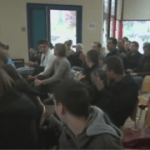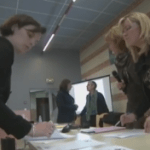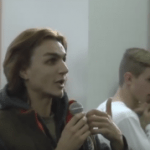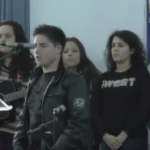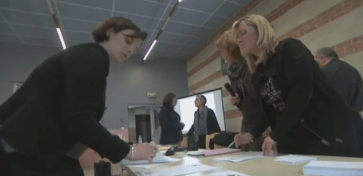
Budget Participatif des Lycées
Description
Inspired by the High School Participatory Budget in Poitou-Charentes, also in France, the Région Nord-Pas-de-Calais established its High School Participatory Budget. This ran between 2009 and 2015. Through the school year, and within each year of the projects duration, 15 or more different high schools were selected by the regional authority in order to enable local school communities to decide on refurbishment projects in their buildings or near the high school, for example within nearby parks or gardens used by young people.
Preparation
The description below, with minor re-editing, is largely taken from one of the resources also listed below, written by Yves Cabannes .
The main objective was to let ‘future citizens’ have a say on their "working" conditions in order to improve their quality of life, especially for students who live in the high school (some high schools in the area are equivalent to boarding schools). Participatory Budgeting in Secondary Schools in the Nord-Pas-de-Calais region aimed to foster a school system that promoted equality of opportunity, and that also gives school children confidence in democratic voting and trust in a political system that seems remote from their day-to-day lives.
A new process in Nord-Pas-de-Calais Region was inspired by a similar experience conducted between 2005 and 2012 in the Poitou-Charente Region where 1800 projects were voted on and the majority of them implemented. It should be noted, however, that the Nord-Pas-de-Calais Region introduced several innovative features to the process. It only began in 2010 as an experiment in five institutions each offering a different type of training (vocational secondary schools; ‘urban’ secondary schools and agricultural secondary schools) enabling the model to be very quickly adapted to each institution. Between 2011 and 2013, PB had been conducted in 25 secondary schools.
Implementation
A description of the process is below, taken from The work of Yves Cabannes referenced below:
“A multistakeholder meeting is typically convened in the autumn term to brainstorm about student needs and to compile suggestions for high school projects.
The regional council (an elected assembly) then reviews the suggestions and evaluates them from a feasibility and financial standpoint.
In the spring, the project ideas are thoroughly debated, and three priority projects are chosen per high school.
The following year, elected regional representatives vote on the financing of each high school’s priority projects within the limit of the available budget.
A steering committee composed of high school directors, teachers, students, academy representatives, regional advisors, and the like meets regularly to oversee the implementation of the projects.”
The team (usually 3 persons) who were responsible for the organisation were generally in attendance during the main event, which presented the outcomes of the evaluation of the proposals ( including their feasibility and costs). That meeting included a voting procedure at the end. Their presence was also helping to ensure a sufficient presence of pupils (instead of teachers) to ensure the process was genuinely youth led.
Ways of engaging young people
Mostly independent participation within unequally sized groups. Each school would convene a council of students, but there was significant variation on how this process worked, based on who led it within each school. In general the process was not embedded with the curricula so participation depended on pupils being released from other commitments.
Material in Italics below taken from the work of Yves Cabannes (referenced below):
From a financial perspective, each school decides upon approximately €100,000, a rather large sum of money that political decision-makers justify by stating, “we do not want to encourage cosmetic participative democracy by asking secondary school students to just choose the colour of the wallpaper. This level of resources allows for genuine projects to improve quality of life or to support educational community initiatives” (Cau, 2013).
Above all, these projects seek to improve the quality of life (for example by purchasing furniture for training centres or by installing water fountains) and to enhance existing facilities, for example, by refurbishing common rooms or boarding school showers (Charter, 2013).
The current PB cycle is spread over two academic years, and allows secondary school students to see the outcomes of the decisions they have made.
The 2013/2014 PB cycle follows seven steps:
(1) Commitment by the Board of Directors of the school and the setting up of a monitoring committee;
(2) Meetings between the monitoring committee and regional authorities;
(3) Joint project development and submission to the regional authorities between September and December 2013;
(4) Examination of projects by the Region regarding feasibility and costs between December 2013 and March 2014;
(5) Debates and voting on priority projects in schools from March to May 2014;
(6) Vote confirmation by the regional authorities from July to October 2014 and finally
(7) Project implementation by the regional authorities before the 2014-2015 academic year.
Once debates and deliberations have been completed, voting is conducted by the simple ‘one person-one vote’ principle and, generally, available resources enable two or three projects to be funded in each school every year.
The Charter, a similar tool to the rules of procedure that exist for many of these processes, stipulates that: “The aim is to reach the minimum threshold of 10% of the total student body of a school at the voting meeting. In addition, students must account for at least half of the voters. The remainder of the persons voting must cover all the following categories: teaching staff; administrative staff; technical and health staff and parents”.
One of the results of this pluralist and original voting method is that the projects selected can benefit both the students and the technical staff. This occurred at the Sallaumines Vocational Secondary School, where the projects chosen for 2011-2013 included: (1) the building of a conference room, an archiving area and a common room for technical staff; (ii) making the playground more attractive and (iii) setting up a language laboratory [www.lp-sallaumines.fr].
A governance model based on the “educational community” concept and a multi-actor monitoring committee
One of the original elements of PB for secondary schools is its governance model. The Monitoring Committee is particularly interesting in several respects. It is made up of a maximum of 15 people; membership is not limited only to secondary school students, although they must have a majority (eight out of 15). The seven remaining members are teachers, administration and technical staff, parents or any other person affiliated with the school.
The Participatory Budgeting Charter clearly stipulates that the gender mix should be respected and all groups should be represented. This monitoring committee drives the entire process and recalls the PB “Catalyst Groups” [grupos dinamizadores] from Seville, Spain. It shoulders many responsibilities and, in particular, “it ensures that the PB process works smoothly with Directorates of the Regional Authorities; that the charter is respected and distributed to all members of the educational community; that PB related issues are properly communicated; is involved in mobilising all stakeholders and their right to free speech and coordinates project delivery”, (Charter, 2013).
As a result, this committee provides a forum for debate and discussion among social groups who usually do not engage with one another or are in conflict. In this way, above and beyond the specific benefits of any projects funded, this diverse committee fosters the concept of an “educational community” put forward by regional political decision-makers. The committee avoids focusing the secondary school issues only through the participation of students but expands it to all concerned actors who have to learn to reach agreements.
Involving the Monitoring Committee all through the two-year process.
Another interesting aspect is that the Committee is responsible for both Participatory Budgeting cycles: determining which projects should be priorities in Year 1 and monitoring the implementation of these projects in Year 2.
In the last 25 years, experience has clearly shown that Year 2 cycle is just as important and perhaps even more than the first year one. It is during the second cycle that ideas become reality and decisions become tangible. In addition, a period of two years is sufficient time for committee members to learn to listen to each other, understand each other and engage in genuine dialogue.
In some cities, Monitoring Committees shoulder more responsibilities, for example, they may participate in openings and analyse tender offers. The committee in the Nord-Pas-de-Calais region also has important functions: “It is involved in selecting equipment (if any): for example, model and colour in line with regional services standards and cost of the project voted on; it can challenge regional services regarding the scheduling of the work to be completed; it takes photographs of projects as they unfold: before, during and after; finally, it organises an event to celebrate the end of projects” (Charter, 2013).
Improving the school environment above and beyond projects
One of the principles of the first set of secondary schools involved in the participatory budgeting process underscores that an important end-result has been achieved: “The school environment is much calmer. There has been a significant decline in the level of anti-social behaviour displayed; there is greater confidence among teachers and students who now feel as though they are playing a part in the changing school structure. There is more respect for the school, its equipment and for ancillary and management staff: they have had the opportunity to get to know each other better and share their points of view...!” (Morelli, 2013)
Scaling up and sustaining the process
A current challenge, noted by a number of stakeholders, is the difficulty of reaching all secondary schools in a short timeframe however we can consider this a predominantly human constraint rather than a financial one. One might very well wonder how disruption to the process, as occurred in Poitou Charente PB, could be prevented: can the existing multi-actor governance model provide continuity to a Participatory Budgeting process currently that is fiercely promoted by only one political party? This is a challenge for the future and for young people.
The other challenge, of course, is understanding the extent to which this highly democratic process will challenge inequality in the Region and assist young people in finding jobs and good living conditions.
References supporting the work of Yves Cabannes include:
CABANNES, Yves (2007:4) Des Budgets participatifs “jeunes” en Amérique latine, ADELS, Paris
CAU, M. 2013. Lycéens citoyens à vous de décider! Lancement du budget participatif des lycées.
Blog de Myriam Cau [Online]. Available: myriamcau.over-blog.com/article-lyceens-citoyens-a-vous-de-decider-lancement-du-budget-participatif-des-lycees-56778389.html 2013].
MORELLI, S. 2013. La démocratie participative appliquée au budget des lycées. La Voix-l’Etudiant.Région Nord-Pas-De-Calais 2013a.
Charte du Budget Participatif des Lycées (BPL) - 2013. www.nordpasdecalais.fr/upload/docs/application/pdf/2013-09/bpl_charte_2013.pdfRégion Nord-Pas-De-Calais 2013b. Rentrée 2013-2014 dans les lycées du Nord-Pas de Calais.Dossier de Presse.
Role of young people
- Participants
Positive aspects of the project/process
The selection of high schools was done based on consideration of objective and subjective criteria defined by the regional strategy of alternative indicators for human development. Indicating there was a positive desire to take PB into the most disadvantaged schools.
Main obstacles to the project/process
Some school managers did not try their best to engage with the less-heard pupils, and a lack of political or institutional backing meant the programme did not achieve the universality or longevity hoped when it began.
Opinion after implementation
There is little systematic evaluation available other than in the French language , and the case is relatively unknown outside France. One of the key learning points from this case is the importance of ongoing political backing and a will to meaningfully share power with pupils.
Much of the description below is taken from the OIDP paper referenced below and was written by Gils Pradeau.
Whilst these experiments look massive when every high school is required to organize PB (in Poitou-Charentes nearly 20 000 students were involved in 2010 and the overall budget decided by the school community is about 10 % of the regional council budget) due to political disagreement in Nord-Pas-de-Calais, only 30 high schools had implemented PB by 2014, so only about 10% of the potential high schools.
PB could provide a greater involvement beyond the pupils delegates as a teacher from Nord-Pas-de-Calais explains: “At the beginning, teenagers don't see the impact PB could have. When we explain how PB works, we tell them they will have to work, and then projects could be implemented in the next 2 years. And some of my students told me in 2 year time, I will have left this high school, so it doesn't have any interest for me. Mobilizing them with this time frame is very difficult but maybe one of our difficulties in this high school is the lack of student mobilization.”
In Nord-Pas-de-Calais, the Regional council has nobody working every day with the students and each year trust has to be renewed by the high schools playing by the rules. Trust can be never taken as granted and the school manager could use many tricks in order to manipulate the results. The most obvious problem is about organizing token participation. O’Miel and Mongy compared two high schools who’s track records contrast with each other:
With a minority of students involved, school managers are more likely to control how the debates are led and have an influence on the final results in the school budget. That’s why after a few years the Regional Council decided that works can’t be implemented if the number of students involved in PB was lower than 10%.
Another way to influence the results is very simple and done prior to the analysis. Before sending the proposals to the Regional Council, some managers filtered the proposals and failed to send some proposals they didn’t want to be implemented. In some high schools, teenagers were not even aware when the voting day was to happen, so they were not ready to prepare a pitch or a campaign for their project, or mobilise other students to come to the voting session. Further, depending on the high school manager, students are not always free to participate in planning, screening or other meetings if they had classes or other learning commitments occurring at the same time.
Whereas by around 2015 within 5 regions in France had in one way or another was somehow implemented a PB in high schools, 10 years after the first experience under the leadership of Ségolène Royal in Poitou-Charentes, none of them are still implementing them. This is largely because of the elections in December 2015 which saw a swing towards new administrations who choose to abandon these projects. PB challenges directly how education is shaped within complex power relations and unless fully institutionalised or mandated they are therefore always at risk from a change in leadership.
However this ‘second wave’ of PB in France is not the end of the story. In Paris a massive ‘third wave’ city wide PB process began around 2015, and it has been reported by an Urbact case study that out of the overall citywide budget “Another proportion (10 million Euros) was reserved for spending on youth and education projects, with schools being encouraged to participate and children's votes determining how that money is spent. Those children in turn may have educated and encouraged their families to take part.”
Pauline Veron, a deputy Mayor in Paris in an article adds: “We have also developed a specific version of the participatory budget for primary and middle school pupils. Students are asked to vote for projects that will occur within their school, whether it is more furniture, more cultural or sporting activities, robotics and so on. This means young citizens are given the opportunity to take decisions that affect their everyday and collective lives, and makes them active citizens from an early age.”
Accountability of resources
Primary accountability lay with the Conseil régional (elected regional authority) as holder of the capital budget for schools that was used in this process.
This means that while it is elected politicians backing the PB that can make them happen, the quality of the delivery will vary based both on their continual political leadership and also the willingness of non elected officials and school leaders to implement a process delivered ‘from the top’.
As commented within a study of a school PB in the region Ile de France around the same time both parents and pupils felt strongly that the PB programme had improved communication and information flowing between the school and pupils. Yet this does not mean those in authority recognised and valued that softer outcomes or maintained the project.
1-3 tips (advices, warnings) from organizers or participants
- Cumulative voting could lead to strategic voting.
- Ballot boxes should not be transparent in order to influence the outcomes (as this can lead to a snowball effect)
- Make sure that there is attention to building broad political acceptance. This project ended when a new ruling coalition came into power in 2015.
Links to examples of application forms, voting styles, tools
Poitou-Charentes’ schools participatory budget:
https://participedia.net/case/24
Detailed Paper on Poiteau Charantes PB at
https://www.oecd.org/gov/digital-government/41095800.pdf
O’Miel, J. & Mongy, A. (2014). Réformer par l'expérimentation : la réception du budget participatif des lycées en Région Nord-Pas-de-Calais. Participations, 9(2), 207-237. doi:10.3917/parti.009.020
Two documentary videos in French:
https://www.youtube.com/watch?v=SYOIeTmkYhc (58 mins)
https://youtu.be/l_1XgczKTR0 (8 mins)
OIDP meeting on youth PB contained observations on this case primarily written by Gils Pradeau upon which we have drawn extensively for this case study,: https://www.oidp.net/docs/Keys_for_child_and_youth_participation.pdf
Another city is possible by Yves cabannes has an extensive description of this case on which we have extensively drawn (Pages 147-153):
http://www.spora.ws/wp-content/uploads/2016/05/Cabannes-Delgado-2015.-Participatory-Budgeting.-Another-City-Is-Possible.pdf
See draft 2018 paper analysing PB in France by Gils Pradeau: https://ecpr.eu/Filestore/PaperProposal/c8ea6720-3973-436d-b931-466fbf1bebe4.pdf
International Practices to Promote Budget Literacy : Key Findings and Lessons Learned includes analysis of this case on P37 and 108
https://openknowledge.worldbank.org/handle/10986/26956
Urbact report on Paris PB:
https://urbact.eu/sites/default/files/490_Paris_GPsummary.pdf
Article by Pauline Veron quoted on Paris’s school PB:
https://medium.com/rsa-journal/participatory-paris-home-of-the-largest-participatory-budget-in-the-world-37425aab9a99
